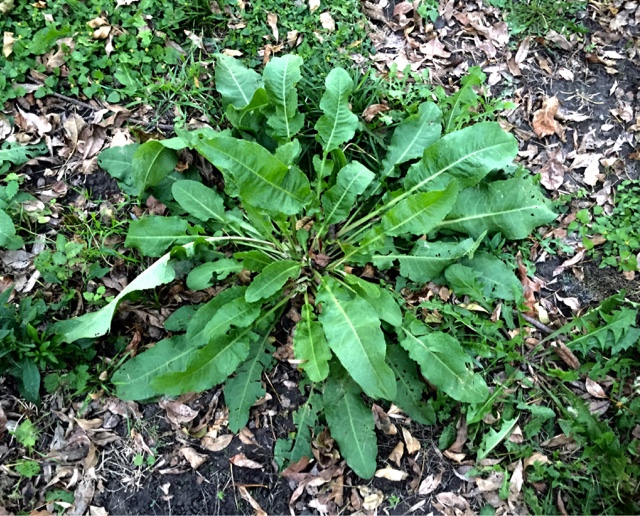 |
| This is one of the most healthy, beautiful curly dock plants I've ever seen |
 Identification difficulty level: novice
Identification difficulty level: noviceCurly dock, Latin name: Rumex crispus, is an excellent wild plant to know. It provides food for at least 6-9 months, and year-round in some climates. It's fairly easy to identify, and grows abundantly throughout all of non-Arctic North America. Curly dock has a mild flavor, a subtly sour note, and a pleasant texture, making it a very versatile ingredient in the kitchen. Curly dock comes from Eurasia, so it's an invasive species here in the Americas. Invasivore eating is one of the most locally-sourced, extremely sustainable ways to look at food.
Easy to ID, delicious, abundant, nutritious, and sustainable? I wonder why everyone isn't jumping on the curly dock bandwagon!
Small warning: curly dock has oxalic acid, and should be avoided by people with rheumatoid arthritis and kidney or liver problems, more on that below.
Curly dock is a two-year plant. In the first year, it just sends up leaves from the root, it spends the year gathering sunlight and storing the energy in the root. In colder climates, the leaves will die away when the snow falls. In the warmer climates you can harvest the leaves throughout the winter.
In the second year, the plant will continue to gather energy, and when it has enough, it will send up a stalk. The stalk will flower, and the flowers will eventually go to seed. Seeds usually form in the late summer or early fall in the north, and late-fall, early summer in the south. The leaves and stalk are edible, the seeds are too, once they've been winnowed. Apparently, the root is medicinal, but I haven't experimented with it yet.
Identification step 1: Growth
Young curly dock grows as a "basal rosette", which is where all the leaves come out of a central point, right at the top of the root. The leaves radiating out form sort of a rose shape, hence the name.
Identification step 2: Leaf
Curly dock leaves are long ovals that start and end at definite points. They have long leaf stems that attach to the root when the plant is young, and to the stalk, after it forms. The leaves have a wrinkling, crinkling or "crisping" on the edges, which is where the Latin name "crispus" comes in.
Curly dock has a translucent, papery "sheath" (called an ocrea) at the end of each leaf stem, where they attach to the root or to the stalk. Sometimes this sheath wears or washes away, but if you don't find it, don't risk eating the plant, because you need it to make a 100% certain identification.
The basal leaves of second year plants are edible in early spring, before the stem forms, and of first year plants throughout the fall (and winter in southern climates).
The leaves are generally from 6-9" long and 2-3" wide, but can grow as long as 14" long and 4" wide, in optimal conditions.
Identification step 3: Stalk
The stalk isn't required to identify the leaves.After a year as a basal rosette of leaves that gathers energy from the sun, the plant will send up a thick, juicy stalk for it's flowers, and later seed. The stalk can have thin streaks of red in the skin.
Once the stalk forms, the lower leaves become tough and stringy. They also loose their flavor. But the young stalk itself, and the smaller leaves that attach to it, are a tasty vegetable in their own right.
The stalk isn't straight, it bends slightly back and forth, at every branch of the leaves. The ocrea is also at every joining of the leaf stems and the stalk.
You can eat the young stem, until it gets tough or woody. Generally, this is as long as you can freely bend it without snapping. However, it has a stringy outer layer, so you will probably want to peel it. Once peeled, it's got a mild greens flavor, like young green beans, but mixed with the sourness of lemon, and can be eaten raw or cooked. It can also be pickled!
 |
| Left: the ocrea at every joining of the leave stems and the stalk. Right: the young flower bud, which is also edible. |
Curly dock nutrition
Curly dock is low calories, contains fair amounts of vitamin A and the B vitamins, and more vitamin C, iron, and magnesium than spinach. (Source: wikipedia)Check out my curly dock recipes here.
 |
| Curly dock that grows in partial shade is healthier and better tasting than when grown in full sun. |
Note of caution: oxalic acid
Many wild greens, including curly dock, contain oxalic acid. Grazing animals can get sick if their field is overwhelmed with docks, and they don't have any other plants to eat.You might be surprised to know that oxalic acid is also found in cultivated greens, like spinach. The levels of oxalic acid in curly dock are safe for healthy adults, but should be avoided by anyone with kidney or liver damage, or by those with rheumatoid arthritis. Even healthy adults should avoid eating oxalates more than one serving a day or so. Even healthy things can be bad for you in large quantities.






I have this growing almost everywhere!
ReplyDeleteThis comment has been removed by a blog administrator.
ReplyDelete